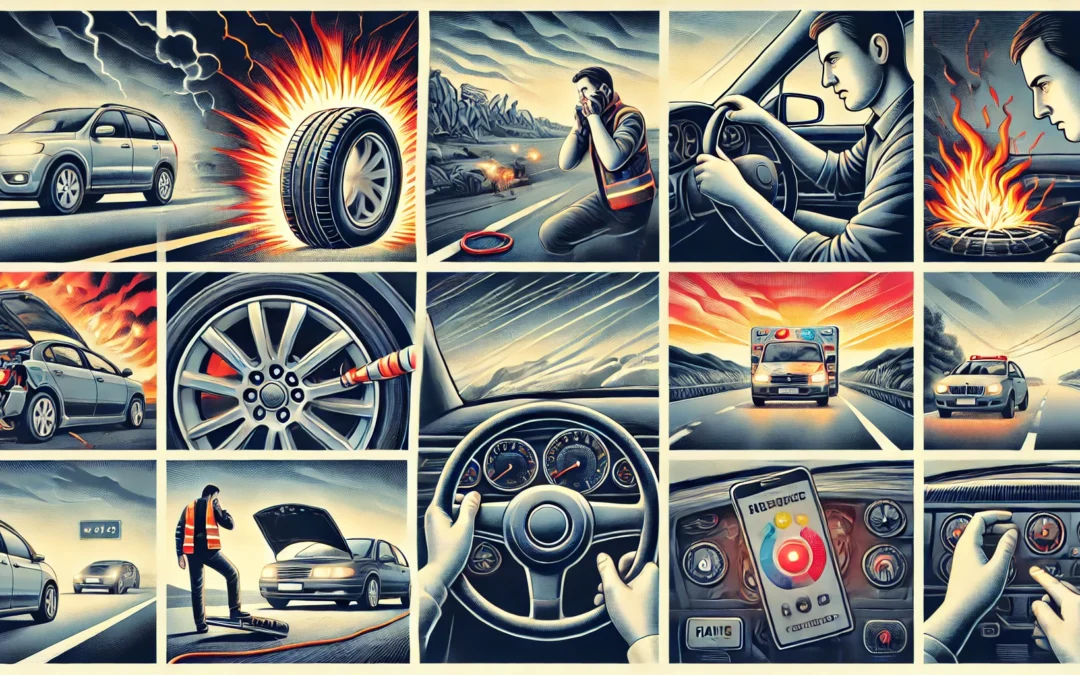How to Handle Emergencies on the Road: A Practical Guide
Emergencies can occur at any time while driving, and how you respond can make all the difference. Knowing how to stay calm and take the right actions in high-pressure situations can help you avoid accidents, keep control of your vehicle, and ensure the safety of everyone involved. Here’s how to handle some of the most common road emergencies effectively.
1. Managing a Tire Blowout
A tire blowout is one of the most frightening experiences a driver can face, but staying calm and knowing what to do can prevent a crash. Here’s how to handle a tire blowout:
- Hold the steering wheel firmly: Both hands should stay on the wheel to maintain control.
- Do not brake immediately: Sudden braking can cause your vehicle to skid or spin. Instead, ease off the accelerator.
- Gradually reduce speed: Allow the car to slow down naturally, and gently apply the brakes when the vehicle is under control.
- Steer towards a safe area: Once you’ve stabilized the vehicle, steer it off the road, preferably onto the shoulder or an emergency lane.
This measured approach can prevent your vehicle from spinning out of control and ensure you can pull over safely.
2. Driving Off the Pavement
Sometimes, you may drift off the pavement onto the shoulder, which can be alarming, especially at high speeds. If this happens:
- Grip the steering wheel tightly to maintain control.
- Ease off the gas pedal: Do not accelerate or brake suddenly. Instead, let the car slow down gradually.
- Steer gently back onto the road when it’s safe. Avoid sharp turns, which could throw you into oncoming traffic.
Carefully steering your vehicle back onto the road, while keeping a steady hand on the wheel, will help you avoid a crash.
3. Overheating Engine
An overheating engine can lead to severe damage if not handled quickly. Here’s what to do if your vehicle’s temperature gauge rises suddenly:
- Turn off the air conditioner: Running the AC puts extra strain on the engine, making it work harder.
- Turn on the heater: This may seem counterintuitive, but turning on the heat draws hot air away from the engine, helping it cool down.
- Pull over as soon as possible: If the engine continues to overheat, stop driving and turn off the car. Wait for the engine to cool before checking the coolant level, and never remove the radiator cap when the engine is hot.
Regular maintenance and checking coolant levels can prevent overheating, but knowing how to react can save your engine from serious damage if it happens unexpectedly.
4. Disabled Vehicle on the Freeway
If your car breaks down on the freeway, it’s essential to minimize your exposure to high-speed traffic:
- Pull over to the right shoulder as far as possible.
- Exit on the passenger side: If you need to leave the vehicle, always exit on the side away from traffic.
- Call for help: Use your cell phone to call for roadside assistance or dial 511 to access freeway services. If it’s available, find a nearby call box.
Always stay in your vehicle with your seatbelt on unless you are in immediate danger from traffic or another hazard. Turn on your emergency flashers to alert other drivers.
5. Dealing with Skids
Skidding is more common in wet or icy conditions, and it happens when your tires lose traction with the road. If you begin to skid:
- Remove your foot from the accelerator immediately.
- Turn the steering wheel in the direction of the skid to regain control of the vehicle.
- Avoid braking: Hard braking will make the skid worse.
By steering in the direction you want to go, you can regain control and prevent a more serious incident.






Recent Comments